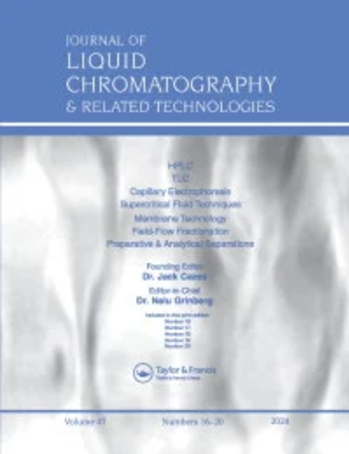Separation of betulin and its derivatives by high-performance liquid chromatography and their determination in extracts of some plants and chaga mushroom
IF 1.2
4区 化学
Q4 BIOCHEMICAL RESEARCH METHODS
Journal of Liquid Chromatography & Related Technologies
Pub Date : 2023-07-03
DOI:10.1080/10826076.2023.2251152
引用次数: 0
Abstract
Abstract The influence of conditions on the separation of betulin (BT), betulinic (BIA), and betulonic (BOA) acids by reversed-phase high-performance liquid chromatography (RP-HPLC) with isocratic elution was studied. It was shown that the order of peaks in chromatograms changed with varying the acetonitrile (ACN) content in the mobile phase, and a poor separation under certain conditions was observed. The highest peak resolution with minimal retention times was at a column temperature of 20 °C, flow rate of 0.25 ml/min, and 92.5% ACN in the mobile phase. The extracts from jujube (Ziziphus jujuba) dried fruit, chaga mushroom (Inonotus obliquus), and white birch bark (Betula pendula) were studied using the obtained conditions. For extracts from the first two sources, it was found that peaks of the compound studied interfered with unknown peaks. By varying the ACN content in the mobile phase with a small step from run to run and tracking the peaks, a baseline separation was achieved. The optimal % ACN in the mobile phase was 87 and 89 for the extracts from jujube and chaga mushroom, respectively. Jujube dried fruit was found to contain, in terms of dry weight of the jujube, 0.223 ± 0.008 mg/g of BIA and 0.044 ± 0.006 mg/g of BOA. Chaga mushroom studied contains 0.022 ± 0.004 mg/g of BT and 0.062 ± 0.009 mg/g of BIA. White birch bark contains 50.9 ± 0.7 mg/g of BT, 11.2 ± 0.3 mg/g of BIA, and 2.5 ± 0.3 mg/g of BOA. GRAPHICAL ABSTRACT高效液相色谱法分离桦木素及其衍生物并测定部分植物和白桦茸提取物的含量
摘要研究了反相高效液相色谱法(RP-HPLC)分离桦木素(BT)、桦木酸(BIA)和桦木酸(BOA)的工艺条件。结果表明,随着流动相中乙腈(ACN)含量的变化,色谱峰的顺序发生变化,在一定条件下分离效果较差。柱温为20℃,流速为0.25 ml/min,流动相ACN为92.5%时,峰分辨率最高,保留时间最短。利用所获得的条件对大枣(Ziziphus jujuba)干果、白桦(Betula pendula)树皮、白桦(Inonotus obliquus)和白桦(Inonotus obliquus)的提取物进行了研究。对于前两种来源的提取物,发现所研究化合物的峰与未知峰相干扰。通过改变流动相中ACN的含量,并跟踪峰值,实现了基线分离。流动相的最佳ACN %分别为87和89。以大枣干重计,发现其BIA含量为0.223±0.008 mg/g, BOA含量为0.044±0.006 mg/g。白桦茸中BT含量为0.022±0.004 mg/g, BIA含量为0.062±0.009 mg/g。白桦树皮中BT含量为50.9±0.7 mg/g, BIA含量为11.2±0.3 mg/g, BOA含量为2.5±0.3 mg/g。图形抽象
本文章由计算机程序翻译,如有差异,请以英文原文为准。
求助全文
约1分钟内获得全文
求助全文
来源期刊
CiteScore
2.80
自引率
0.00%
发文量
29
审稿时长
4.9 months
期刊介绍:
The Journal of Liquid Chromatography & Related Technologies is an internationally acclaimed forum for fast publication of critical, peer reviewed manuscripts dealing with analytical, preparative and process scale liquid chromatography and all of its related technologies, including TLC, capillary electrophoresis, capillary electrochromatography, supercritical fluid chromatography and extraction, field-flow technologies, affinity, and much more. New separation methodologies are added when they are developed. Papers dealing with research and development results, as well as critical reviews of important technologies, are published in the Journal.

 求助内容:
求助内容: 应助结果提醒方式:
应助结果提醒方式:


